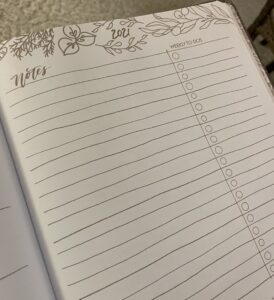Today’s blog has a guest author — Adam Waddle. As someone who works in front of a computer most of the day, he is here to add his perspective to our conversation about planners and the variety available.
Let’s get this straight right from the start. You need to plan for tomorrow. The first and most important step in daily planning is admitting that you need it. Tools, steps, and tips are secondary to the humility needed to recognize that you cannot successfully manage your day without prior planning and the diligence to put in the work. Now that I have gotten your attention, here is how I do it.
My job keeps me tethered to my office computer. With a company computer and software, I do not have permission to add fancy daily planning software. But I can adapt.
- First, I check my calendar to review meetings. Meetings where I am host or presenter are color-coded. These require pre-meeting work. Hosting a meeting means preparing an agenda. A meeting without an agenda is a mess. Imagine going to the grocery store without a list. It never works well.
- Secondly, I review my To-Do list. I use an unsent draft email to generate an action item list throughout the day. I add to it as I answer phone calls, sit through meetings, read over emails. This is an electronic version of post-it notes or scratch paper. It can be a bit disorderly, but at the end of day I review my notes and organize them for the next day. I even prioritize the notes so that I will be sure to see the most important notes in the morning when I review them.
- Lastly, I use my Inbox as the safety net to catch my unfinished business. I read my emails each day, delete the useless ones, and store the important and finished ones. But if an email contains some action that I need to follow up upon, then I leave it in the Inbox. My goal is to keep my Inbox at the lowest count possible. I can tell that my week is getting away from me by a quick glance at the Inbox. Too many emails in the Inbox means that I have let something linger too long. Time to stop and review again.



 The planner is 8″x10″ and includes the usual month and week spreads. The week has days on one page, and space for notes and a task list are on the other. You can easily keep track of time commitments and what you need to do during the week generally. The Notes space could be used for anything you need, including meal planning or grocery lists or project planning or books read.
The planner is 8″x10″ and includes the usual month and week spreads. The week has days on one page, and space for notes and a task list are on the other. You can easily keep track of time commitments and what you need to do during the week generally. The Notes space could be used for anything you need, including meal planning or grocery lists or project planning or books read. A highlight of the planner is the monthly Gratitude List. What a great way to promote thankfulness in our hearts!
A highlight of the planner is the monthly Gratitude List. What a great way to promote thankfulness in our hearts! Speaking of gratitude…there are several spreads in the back of the planner specifically for prayer requests and documenting answers to prayer.
Speaking of gratitude…there are several spreads in the back of the planner specifically for prayer requests and documenting answers to prayer.